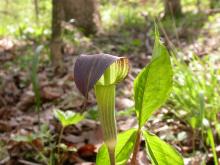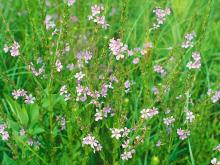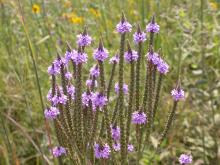Wildflowers, Grasses and Other Nonwoody Plants
Media

Species Types
Scientific Name
Arisaema triphyllum
Description
Preacher Jack in his “pulpit” is sheltered by the canopylike spathe, which is green with white and brown lengthwise markings. An unforgettable spring wildflower, Jack-in-the-pulpit is common throughout the state.
Media

Species Types
Scientific Name
Perilla frutescens
Description
Introduced as an ornamental, beefsteak plant is native to Asia. It is common in moist or dry wooded bottomlands, open valley pastures, and along trails, railroads, and roadsides. It spreads invasively in our state.
Media

Species Types
Scientific Name
Lythrum salicaria
Description
Anyone who’s seen what purple loosestrife has done to New England and the Northeast can tell you how invasive this plant is. Learn how to identify it, so you can report any findings to the Missouri Department of Conservation.
Media

Species Types
Scientific Name
Dioscorea oppositifolia (sometimes called D. batatas)
Description
Similar to kudzu, Chinese yam is an aggressive vine that overtakes nearly everything within reach that stands still long enough! Learn more about this invasive plant — and please don’t plant it!
Media

Species Types
Scientific Name
Physostegia virginiana
Description
False dragonhead is called "obedient plant" because when you push one of the flowers sideways, it "obediently" stays in place for a while.
Media

Species Types
Scientific Name
Ambrosia trifida
Description
Large stands of wind-pollinated giant ragweed commonly form in disturbed areas, causing late-summer misery in the form of hay fever for many Missourians.
Media

Species Types
Scientific Name
Blephilia ciliata
Description
Square, unbranching stems, opposite leaves, two-lipped flowers, and a mild minty fragrance are clues Ohio horsemint is in the mint family. Tight, rounded flower clusters are stacked atop one another at the stem tips.
Media

Species Types
Scientific Name
Prunella vulgaris
Description
A square-stemmed plant with opposite leaves, self-heal bears two-lipped blue, lavender, or violet flowers in a cylindrical head. We have two varieties of self-heal in Missouri, one native and one introduced.
Media

Species Types
Scientific Name
Lythrum alatum
Description
Winged loosestrife is a native Missouri wildflower that should not be confused with the nonnative invasive purple loosestrife. Learn to distinguish between the two so you can report infestations of the latter!
Media

Species Types
Scientific Name
Verbena hastata
Description
Blue vervain is a tall, slender, erect perennial with branching stems and rough hairs. Its tubular flowers are clustered in many terminal spikes, and can be deep purple, violet, light lavender, or rarely white.
See Also
About Wildflowers, Grasses and Other Nonwoody Plants in Missouri
A very simple way of thinking about the green world is to divide the vascular plants into two groups: woody and nonwoody (or herbaceous). But this is an artificial division; many plant families include some species that are woody and some that are not. The diversity of nonwoody vascular plants is staggering! Think of all the ferns, grasses, sedges, lilies, peas, sunflowers, nightshades, milkweeds, mustards, mints, and mallows — weeds and wildflowers — and many more!





















